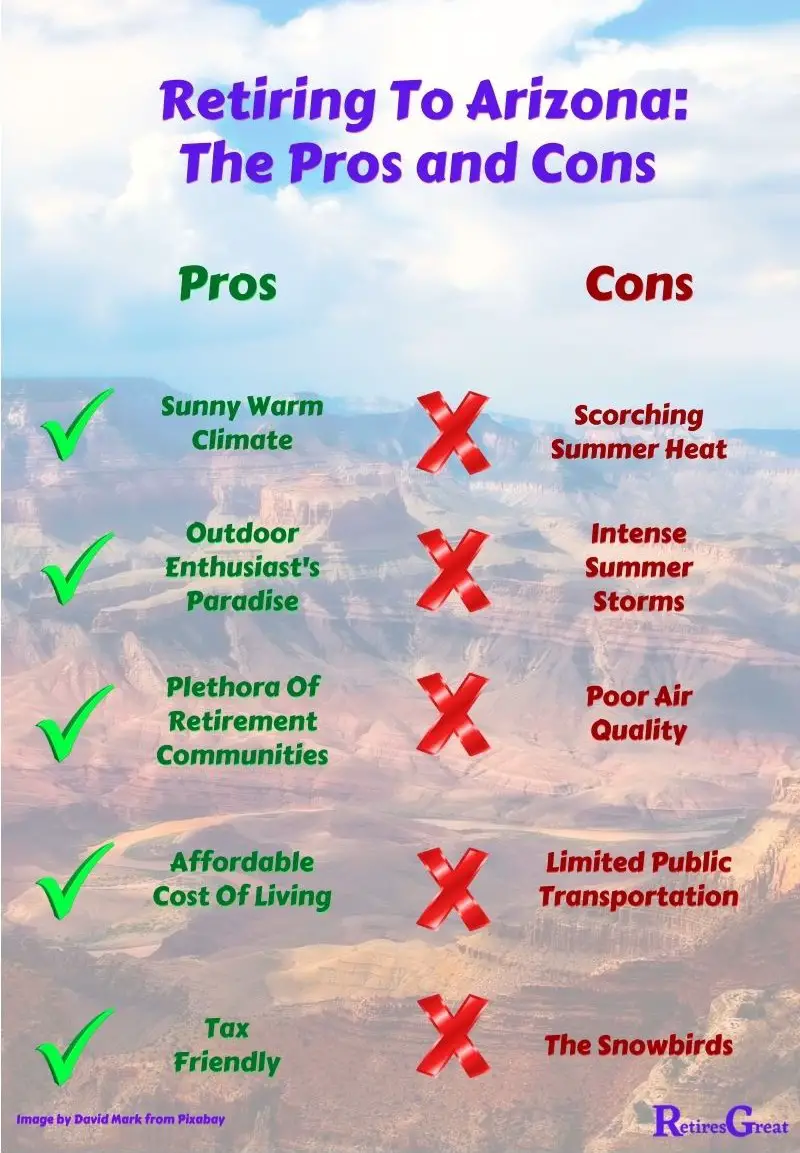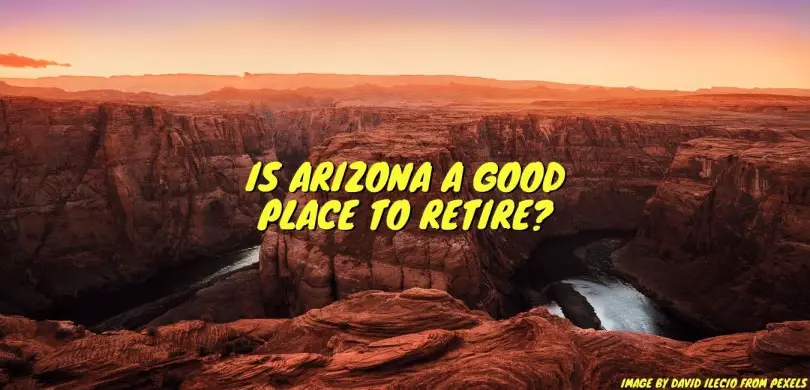One of the most popular retirement destinations is Arizona. There’s lots of hype when it comes to the “Grand Canyon State” and one needs to understand the pros and cons of living in Arizona. More importantly, is it right for you?
Is Arizona a Good Place to Retire?
Arizona can be a good place to retire due to an affordable standard of living, favorable taxes and proliferation of 55+ communities. In addition, the state boasts a year-round warm dry climate with over 300 days of sunshine.
This is a retirement friendly state. According to Smart Asset, 56,000 people over the age of 60 arrived in 2019. Nearly 18% of the population is already 65 or older with a whopping 36% of Arizonians over the age of 50.
Many choose to live in the multitude of retirement communities catering to older adults. These are self-contained developments which provide a vast array of social and recreational activities. During the winter months, tourism soars with the arrival of the “snowbirds”.
It’s an ideal retirement destination with mild temperatures, plenty of sunshine and lots of outdoor activities, especially during the cooler months.
The greatest drawbacks are the scorching summer heat and all that entails. Average highs in July are 106°F and, on occasion, can hit as high as 120°F. Further exacerbating this heat are violent summer storms withs wildfires, haboobs and flash floods.
Whether or not retiring to AZ is right for you comes down to personal preferences. The following pros and cons of living in Arizona expand upon these factors.

The Pros of Living in Arizona
The Grand Canyon State is a retiree-friendly state with breath-taking scenery and a warm climate. The cost of living, favorable taxes and so many outdoor activities make it a popular retirement destination.
1. Sunny Warm Climate
“Snowbirds” flock to AZ to enjoy the mild winters. Daytime temperatures are the high 60s during December, gradually warming throughout the winter.
Holding the distinction of being the sunniest state, the Valley of the Sun (aka greater Phoenix area) alone receives around 300 days of sunshine annually.
Studies show sunny weather improves our overall mood and well-being. Energy levels increase and it feels good to get out and do things. This is especially important for seniors who might otherwise might feel “house bound”, or anyone susceptible to seasonal affective disorder (SAD).
In addition, sunlight is the best source of vitamin D. Not only does it boost our immune system, it can help ward off cancer, maintain strong bones and reduce stress.
The warm dry climate is another plus for those suffering health related concerns such as arthritis, asthma, allergies or mobility issues. Warmer temperatures can minimize symptoms allowing participation in more activities.
2. Outdoor Enthusiast's Paradise
The Grand Canyon is the most visited national park in the US attracting almost 6 million visitors each year. Yet, there’s so much more spectacular scenery to see. In addition to three national parks, there are over thirty state managed parks and natural areas.
Some of the popular outdoor activities include hiking, mountain biking, rafting, horseback riding and golf. There are over 600 maintained trails and the famous “Arizona Trail” is 800 miles long.
For the golf enthusiast, there are more than 300 courses across the state.
3. Plethora Of Retirement Communities
One of the greatest benefits of retiring to AZ is the wide selection of 55+ communities. On January 1, 1960 Sun City opened and holds the title of being the longest running age restricted community in the country.
The development focuses on providing a self-sustaining active adult community for retirees. The concept proved successful and has spread nation-wide. Arizona continues to lead the way with 144 communities scattered throughout the state.
The real value they offer is independent living. This includes a vibrant social setting, lots of fun activities and easy access to almost every imaginable amenity. One of our most popular articles, Advantages of 55+ Communities, goes into greater depth.
Mind you, they aren’t for everyone, as we discuss in Disadvantages of Retirement Communities.
4. Affordable Cost of Living
Arizona used to be far less expensive; however, it can still offer an affordable lifestyle for those on fixed incomes.
According to Meric’s 2022 Cost of Living Index, the state ranked in 37th position with an index of 105.8. In contrast, Florida in 32nd place, was slightly less expensive with an index of 102.8. As a further reference point, more expensive California came in 49th, with an index of 137.6.
What most hurts Arizona’s affordability score are high housing costs which have increased over 40% during the past five years. According to Zillow, the average cost of a Phoenix home was slightly over $400,000.
Interestingly, retirement communities can reduce these housing expenses. For example, in nearby Sun City, Zillow determined the median price to be $289,252. Granted, newer developments can be pricier.
The state tax regime is favorable for seniors, which also helps with living expenses.
5. Tax Friendly
Overall, the state is considered moderately tax friendly to seniors, particularly for those with low income. For example, Social Security and military pensions are exempt, as are inheritance and estate taxes.
Income tax is calculated on a graduated basis starting at 2.5%. This is anticipated to become a flat tax for 2023. Additionally, the Senior Property Valuation Protection can reduce or eliminate property taxes for lower income seniors over the age of 65.
The Cons of Living in Arizona
As wonderful as it sounds, there are downsides to living in an arid desert state. The summers are intensely hot with the risk of dust storms (haboobs), wildfires and even flash flooding. Public transportation is limited and air quality is poor in cities such as Phoenix.
1. Scorching Summer Heat
Any way you slice or dice it, AZ is scorching hot during the summer months. From the end of May through to mid-September, the mercury regularly climbs above the 100°F mark. Phoenix holds the dubious distinction of being the hottest city in America. Literally, it’s hotter than a firecracker!!
The only saving grace is it’s a “dry heat” and slightly more bearable than the sweltering heat of cities such as New Orleans. The “Big Easy” is surrounded by water with relative humidity climbing to 80% or higher. With highs in the mid-90s, this becomes an energy sapping huge sauna.
Of greater concern is the changing weather pattern. 2020 was the hottest summer on record with 53 days topping 110°F. This is expected to increase to 80 days by 2050. Climatologists warn that Phoenix may become uninhabitable within the next 20 to 40 years.
According to States at Risk, the number of dangerous heat days is expected to increase from 50 to 80 by 2050. This changing weather will also increase the risk of drought, wildfires and flash flooding.
2. Intense Summer Storms
The summer months are punctuated with intense storms. Although generally short-lived, the intense heat creates volatile storm cells. These can produce lightening, hail, heavy downpours and damaging winds. In some cases, these storms lead to flash flooding.
A collapsing thunderstorm can, also, create the perfect conditions for a “haboob” or dust storm. These are giant walls of sand / dust which can reach up to 10,000 feet in height with wind speeds of up to 60 m/h. Fortunately, they blow over in 10 to 30 minutes.
3. Poor Air Quality
With over two million motorists commuting each day, vehicle emissions have created an ever-present blanket of smoke over the valley. Surrounded by mountains, the sun and high temperatures create the ideal conditions for smog / ozone.
The smoke from wildfires and preventative burn offs further degrades the air quality.
“The Phoenix metro area is the 5th most polluted city in the country in terms of ozone, or smog, levels. And this year, Phoenix also jumped to the 11th highest spot for particulate matter pollution” JoAnna Strother, American Lung Association
Air pollution increases adverse health risks especially in children, older adults and those with chronic or pre-existing conditions. Definitely something to be aware of when retiring to AZ.
4. Limited Public Transportation
Unlike other major cities which built upward, Phoenix expanded outward. The metropolitan area now covers 14,565 square miles. The region has become highly car-centric as everything's so spread out. The public transportation is rather limited and a vehicle is almost necessary.
An interesting observation is the many older cars still on the road. With an absence of snow and salt, they generally last longer. All this contributes to an ever-increasing number of vehicles on the road and rush-hour traffic congestion.
5. The Snowbirds
Each winter marks the arrival of the “snowbirds” flocking south to escape the cold. These are predominately retirees from the northern states and Canada. By some estimates, they inject as much as a billion dollars into the local economy each season.
Many own properties whereas others arrive with RVs. Their typical stay ranges from three to six months.
They, also, swell the population with estimates of 400,000 plus. Everything becomes busier including traffic congestion, line ups in stores / restaurants and even availability of tee-off times. As good as they might be for the economy, year-round residents often resent their intrusion.
Closing Thoughts on Retiring to AZ
There are many reasons the Grand Canyon State remains popular for retirees from across the nation. They’re attracted by the sunny mild winters, spectacular landscapes, affordability and retiree friendly lifestyle.
Several of my friends are “snowbirds” and greatly extol the virtues of Arizona.
Yet, it’s not for everyone. While half the year is pleasant, the other half becomes a raging inferno. Climate change is accelerating which means more extreme heat, summer storms, flash floods and wildfires.
For my two cents worth, it’s a great place to visit with so much to see and do. However, I would wither in the heat and slow roasting isn’t really my cup of tea. Again, that’s a personal preference for each of us.


Nice post. I learn something totally new and challenging on websites
I agree with your point of view, your article has given me a lot of help and benefited me a lot. Thanks. Hope you continue to write such excellent articles.